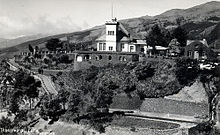Caminho de Ferro do Monte
| Caminho de Ferro do Monte | |||||||||||||||||||||||||||||||||
|---|---|---|---|---|---|---|---|---|---|---|---|---|---|---|---|---|---|---|---|---|---|---|---|---|---|---|---|---|---|---|---|---|---|
| Route length: | 3.911 km | ||||||||||||||||||||||||||||||||
| Gauge : | 1000 mm ( meter gauge ) | ||||||||||||||||||||||||||||||||
|
|||||||||||||||||||||||||||||||||
The Caminho de Ferro do Monte (also Comboio do Monte or Elevador do Monte ) was the only railway line with passenger traffic on the island of Madeira ( Portugal ). The route ran as a rack railway from the Pombal station in Funchal to Terreiro da Luta above Monte . The route, built in several sections, had a length of 3.911 km.
Planning and construction
The first plans for the Caminho de Ferro do Monte were made in 1886 by the engineer Raul Mesnier Ponsard . Joaquim António Marques had the idea of building an elevator or a railway, who received approval from the Funchal City Council on February 17, 1887.
After overcoming some difficulties in raising capital, the Companhia do Caminho-de-Ferro do Monte was formed. Work on the line began on August 13, 1891, and the first section between Pombal and the Levada de Santa Luzia was inaugurated on July 16, 1893.
On August 5, 1894, the line reached Atalhinho (Monte), 577 meters above sea level.
On July 12, 1910, the general meeting of Companhia do Caminho-de-Ferro do Monte decided to extend the route to Terreiro da Luta. The Funchal City Council approved this project on August 4th of the same year.
The train first reached this station on July 24, 1912 and had climbed 850 meters in altitude. The total length of the route was 3,911 meters, with the stops Pombal, Levada de Santa Luzia, Livramento, Quinta Sant'Ana (Sant'Ana), Flamengo, Confeitaria, Atalhinho (Monte), Largo da Fonte and Terreiro da Luta.
The company's offices were on Rua do Pombal in the main train station. During the season there was a panorama restaurant in Tereiro da Luta, operated by the Companhia do Caminho-de-Ferro do Monte .
Construction phases
| Route section | Route length | Installation |
|---|---|---|
| Pombal - Levada de Santa Luzia | 1,000 km | July 16, 1893 |
| Levada de Santa Luzia - Atalhinho (Monte) | 1,500 km | August 5, 1894 |
| Atalhinho (Monte) - Terreiro da Luta | 1.411 km | July 24, 1912 |
Operating history
On September 10, 1919, the boiler of a locomotive exploded while driving uphill. This accident resulted in four deaths and several injuries. Because of this catastrophe, the trips were suspended until February 1st, 1920. On January 11, 1932 there was another accident, this time due to derailment. As a result, tourists and locals no longer took the train because it seemed too dangerous. Together with the fact that the tourists stopped visiting Madeira as a result of the Second World War , the railway company got into a crisis. The last run of a train took place in April 1943, after which the route was discontinued and quickly dismantled. Some of the material recovered from the dismantling, including the rails, was scrapped and the other part was used in the repair of the Elevador do Bom Jesus in Braga .
Technical specifications
The Caminho de Ferro do Monte was a rack railway based on the Riggenbach system . It was laid out on a single track in meter gauge. In Livramento and Monte there were passing points where trains could cross. The trains each consisted of a locomotive and a single car, which was pushed uphill by the locomotive. On the descent, the weight of the car pushed down so there was no need for a clutch.
vehicles
The company had five locomotives (four built by Maschinenfabrik Esslingen and one by SLM Winterthur ) and five passenger cars (each with a capacity for 60 people). There were also some small wagons for the transport of luggage.
Current
The former station building and the railway bridge still exist in Monte. The city of Funchal is currently considering the future of the Teleféricos da Madeira (German elevators ). The project includes the construction of a funicular between the old Terreiro da Luta and Monte stations on the old route. The reconstruction to the center of Funchal is not planned. This project is suspended due to financial difficulties in the current economic situation, there is no forecast for a date for implementation. Since the Funchal – Monte cable car has existed since 2000 , the project of a cable car on the route of the rack railway is no longer relevant. Nevertheless, in connection with the bankruptcy of the Achenseebahn, there were repeated reports in the Austrian media speculating about a sale of the historical material to Madeira.
gallery
Web links
- Caminho do comboio no Funchal em 1898. (Photos). Archived from the original on November 9, 2013 ; accessed on June 9, 2020 (Portuguese).
Individual evidence
- ↑ a b c d “Do Pombal ao Bom Jesus de Braga”, Jornal da Madeira
- ↑ a b c Ranse-Wallis: Um fotógrafo entusiasta dos Caminhos de Ferro (II) - O Caminho de Ferro do Monte, author Jorge Bonito, 2007 ( Memento from September 20, 2013 in the Internet Archive ) (PDF file; 1.23 MB)
- ↑ a b c d e f g Silva, JR e Ribeiro, M. (2009). Os comboios de Portugal - Volume V . 1ª Edição, Terramar, Lisboa
- ^ O Comboio do Monte eo elevador do Bom Jesus
- ↑ a b Comboio do Monte é mais-valia para o turismo , Miguel Fernandes, Jornal da Madeira
- ↑ Walter Zwicknagl: Achenseebahn steams towards world cultural heritage. June 7, 2020, accessed June 9, 2020 .














